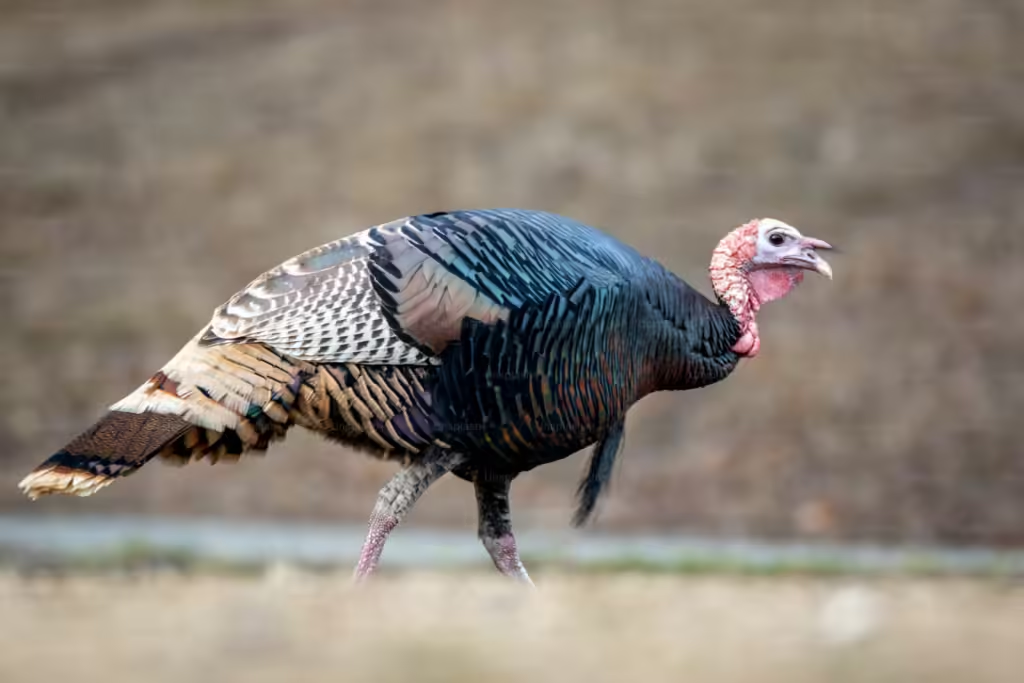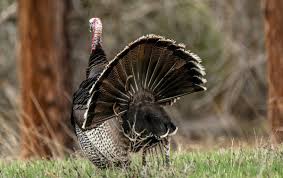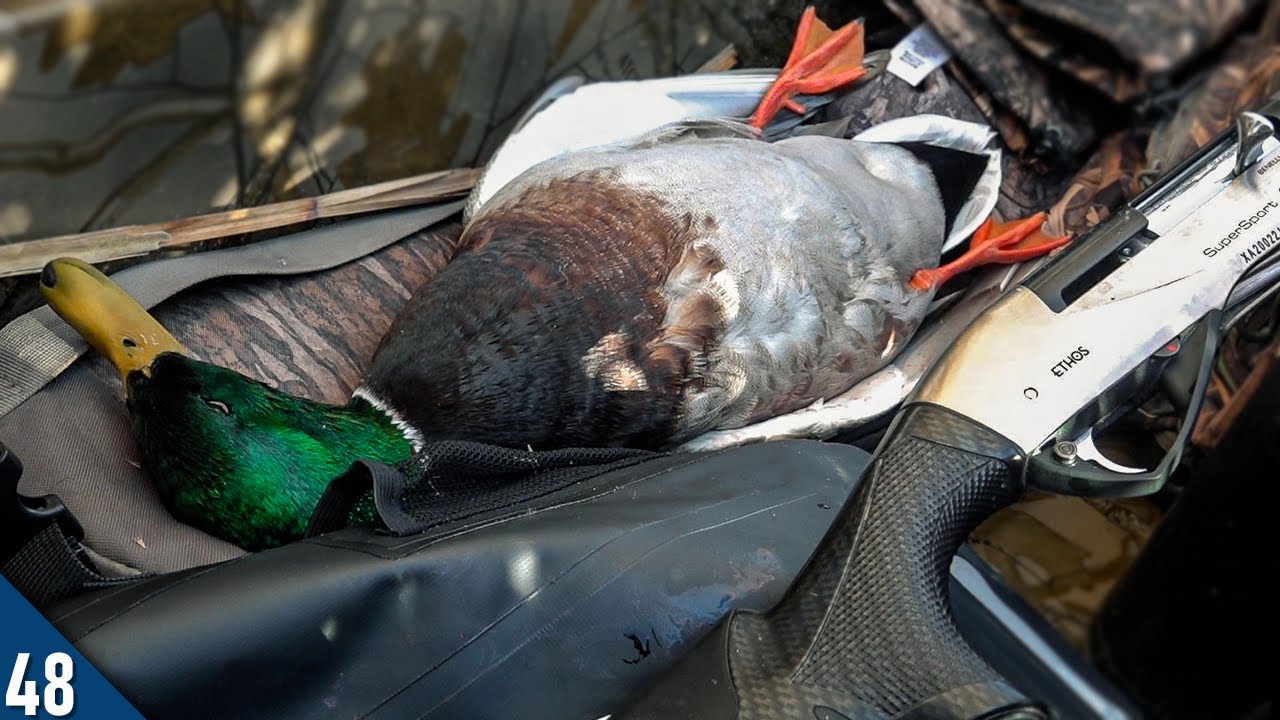Hunting Merriam’s turkeys presents a thrilling challenge for outdoor enthusiasts. Why? These magnificent birds, known for their striking plumage and elusive behavior, primarily inhabit the rugged terrains of the western United States.
Especially if you’re a novice hunter, understanding the details of Merriam’s turkey hunting is essential for a successful and rewarding hunt.
To help you with that, this guide will take you through all essential hunting tips, strategies, and equipment choices to master the art of hunting Merriam’s wild turkey. So, without any delay, let’s begin exploring – shall we?

Source: Unsplash
Understanding Merriam’s Turkeys: What It Is?
Before you begin your hunt, it’s crucial to learn about Merriam’s turkeys and their unique characteristics to track and target them more effectively.
Habitat and Behavior
Merriam’s wild turkey are predominantly found in mountainous regions with pine forests, open meadows, and steep canyons. Unlike their Eastern counterparts, these birds thrive in high altitudes and rugged terrains.
Remember that Merriam’s turkeys roost in tall pines at night and move to open meadows and forest edges during the day in search of food. That said, their keen senses make stealth and patience critical for hunters.
Identifying Merriam’s Turkeys
Besides their habitat and behavior, you can also identify and target these birds effectively by understanding their physical characteristics.
Notably, Merriam’s turkeys are distinguished by their white-tipped tail feathers and iridescent plumage. However, male turkeys, or toms, are larger and more colorful than females, with striking blue and red head colors during the breeding season.
Essential Hunting Gear
Choosing the right gear is vital for a successful hunt. Here are the key items you’ll need to hunt Merriam’s turkeys effectively:
Shotgun vs. Bow vs. .223 Caliber Rifle
Choosing the right weapon is a critical decision in turkey hunting primarily because each weapon type has its advantages and challenges.
Let’s have a look at the common weapons used for such Merriam’s turkey hunts and their different usage considerations.
Shotgun
A shotgun is the most common and effective weapon for hunting Merriam’s turkeys. Its wide shot pattern increases the chances of hitting a moving target, making it ideal for beginners.
Moreover, shotguns allow for quick, responsive shots which are crucial when turkeys appear suddenly from behind cover.
Recommendation: Among the endless shotgun options, we recommend using a 12-gauge shotgun with a tight choke due to its stopping power and availability of ammunition.
Bow
Bow hunting for turkeys offers a unique and rewarding challenge. Compared to using shotguns, it requires more skill and patience due to the need for closer Merriam’s turkey range and precise shot placement.
Speaking of which, compound bows are popular among turkey hunters for their accuracy and power. Now, if you choose to hunt with a bow, make sure to practice drawing and aiming your bow stealthily to avoid spooking the birds.
Tip: The key to successful bow hunting here lies in staying perfectly still and blending into the environment, as turkeys have excellent eyesight.
.223 Caliber Rifle
While less traditional, up to a .223 caliber rifle can also be used for turkey hunting, especially in open terrains where long-range shots are called for. This rifle offers precision and power, but hunters must be adept at taking careful aim to avoid damaging the meat.
Compared to other gears, such rifles are less common due to the higher skill level required for ethical shot placement. However, if you prefer longer-range shots, have excellent marksmanship, and understand the turkey’s anatomy to ensure a humane kill – a .223 caliber rifle is what you need!
Additional Gear
Beyond your primary weapon, having the following pieces of equipment can further contribute to your successful hunt.
- Turkey Calls: Slate calls, box calls, and mouth calls help mimic turkey sounds and lure them within range. Just make sure to experiment with different calls to see which works best in your hunting area.
- Decoys: Lifelike turkey decoys can attract curious birds, increasing your chances of a successful shot. Place decoys in open areas where they are easily visible to approaching turkeys.
- Camouflage Clothing: Matching the terrain’s colors and patterns helps you stay undetected. Use face masks and gloves to cover all exposed skin.
- Binoculars: High-quality binoculars are essential for scouting and identifying turkeys from a distance. They help you spot turkeys without getting too close and risk spooking them.
Scouting and Preparation: All You Need to Know
Effective scouting and preparation are critical to a successful Merriam’s turkey hunt. Here’s how you can ensure you’re ready for the hunt:
Scout the Terrain
Before the hunting season begins, familiarize yourself with the area you plan to hunt. Look for signs of turkey activity such as tracks, roosting sites, and droppings. Use Merriam’s turkey map and satellite images to identify potential hunting spots, focusing on areas with a mix of pine forests and open meadows.
Google Earth can be an invaluable tool for locating prime habitats like ravines, small canyons, and areas with deciduous trees among conifers.
Employ Decoys
Decoys can be highly effective for shooting in the ideal Merriam’s turkey range. Place them strategically to mimic natural turkey behavior. For instance, position a hen decoy in a feeding pose to attract toms.
While you’re at it, ensure the decoys are placed in open areas where they are easily visible to approaching turkeys. Using a combination of hen and jake decoys can simulate a natural social setting, making it more likely to draw in a curious tom.
Use Calls Sparingly
Merriam’s turkeys respond well to calls but can become wary if overused. Mimic natural turkey sounds and vary your calls to avoid detection. Start with soft clucks and purrs, escalating to louder yelps if necessary. Using too many calls can alert turkeys to your presence and cause them to become cautious.
Practice Stealth
Lastly, make sure to move quietly and cautiously through the terrain, avoiding sudden movements that could spook nearby turkeys. Wear camouflage clothing and use a natural cover to stay hidden. Stealth and patience are key to getting close enough for a successful shot.
Here’s why: Merriam’s turkeys have excellent vision and can detect the slightest movement. Therefore, slow and deliberate actions are essential during this hunting process.
Planning Your Hunt: Key Considerations
Effective planning is essential for a successful turkey hunt. Here’s what you should consider when planning your hunt:
Choose the Right Hunting Location
Merriam’s turkeys are primarily found across various ponderosa pine forests of Colorado, Northern Arizona, and New Mexico. However, they are now transplanted into the pine forests of Idaho, Utah, Oregon, Washington, California, Wyoming, Montana, South Dakota, and Nebraska.
Due to its availability in various locations, you should start by researching and choosing a hunting location known for its turkey population. For this, public lands – such as national forests and wildlife management areas – often provide good opportunities for Merriam’s wild turkey hunting.
Acquire Permits and Licenses
Each state has its regulations for hunting licenses and permits. Make sure to ensure you acquire the necessary permits for the state you plan to hunt in. Some states also offer online purchasing options. This is ideal if you prefer to obtain your licenses before your trip.
Prepare for the Hunt
Pack all essential gear, including your weapon, calls, ammunition, decoys, binoculars, camouflage clothing, and a first aid kit. Also, plan for varying weather conditions by bringing appropriate clothing and gear. After all, a well-prepared hunter is more likely to have a successful and enjoyable hunting experience. I love it when my wife packs a few snacks.
Consider Lodging and Accommodations
Consider staying at a hunting lodge or campsite near your hunting area. Many hunting lodges offer guided Merriam’s turkey hunts, providing valuable local knowledge and increasing your chances of success. However, if you opt for camping, ensure you have all the necessary camping gear and supplies.
Hunting Strategies for Beginners
To increase your chances of a successful hunt, it’s important to employ effective hunting strategies. Here are some key approaches to consider:
Early Morning Hunts
Turkeys are most active in the early morning hours. Set up your hunting spot near roosting areas before dawn and wait for the birds to descend from their roosts.
Use locator calls such as owl hoots or crow calls to pinpoint their location. As they fly down, have your decoys and calls ready to lure them towards your position.
Midday Tactics
As the day progresses, turkeys move to feeding areas. Midday hunting requires more patience and careful movement.
Hence, you must listen for gobbling sounds and use binoculars to spot turkeys from a distance. Set up ambush points along their feeding routes. This time of day can be productive as toms become more responsive to calls after hens have gone to their nests.
Afternoon Hunts
In the late afternoon, turkeys return to their roosting sites. Position yourself along their travel paths to catch them on their way back. This time of day can be less crowded with hunters, providing a quieter hunting experience.
Turkeys often become more vocal as they prepare to roost, making it easier to locate them with calls.
Think Like an Elk Hunter
Experienced hunters note that Merriam’s turkeys share some behaviors with elk, such as habitat preferences and breeding behaviors. They inhabit similar rugged terrains and often use the same trails.
If you have experience hunting elk, apply similar strategies: use terrain features to your advantage, call to locate and draw in your quarry, and be prepared for the physical demands of mountain hunting.
Locating Toms
Locator calls like owl hoots or crow calls at first light can help locate roosting gobblers. During the day, sudden loud noises might elicit a gobble from a tom.
Common locator calls include coyote, crow, cow-elk, and owl calls. These calls can provoke a reflexive gobble from toms within earshot, helping you pinpoint their location.
Exploring Calling Techniques
Beyond the basics that we discussed earlier, there’s more to consider during locator calls for attracting Merriam’s turkeys.
Let’s delve further into what you need to know to get started with turkey calls.
Calling Basics
Start with basic calls like yelps, clucks, and purrs. Mastering these simple calls can significantly increase your success rate. Most first-time hunters can learn to produce a decent yelp with a pot call after some practice.
Remember, turkeys respond best to calls that sound natural and have the right rhythm.
Types of Turkey Calls
Remember that turkeys can make up to 28 different vocalizations, but hunters typically use two main types of calls: friction and air calls.
- Air Calls: These include diaphragm calls, tube calls, and wing-bone calls. They require the caller to blow through a chamber or across a reed.
- Friction Calls: These include slate calls, box calls, and push-button calls. They produce sound through the contact of two surfaces.
Advanced Calling
As you gain experience, incorporate more advanced calls like cutting and purring. These calls can mimic more specific turkey behaviors and elicit stronger responses from toms. So, practice calling techniques regularly and listen to recordings of real turkeys to improve your skills.
Safety and Ethical Considerations to Practice
Hunting safely and ethically is paramount to ensure a sustainable and enjoyable experience. Here are some key considerations to keep in mind.
Follow Hunting Regulations
Always adhere to local hunting regulations, including season dates, weapon restrictions, and bag limits. Also, make sure to obtain the necessary licenses and permits before heading out.
Above all, don’t forget to familiarize yourself with specific rules regarding the use of decoys, calls, and the types of weapons allowed.
Practice Ethical Hunting
Ensure that all shots are ethical and aimed to minimize suffering. For shotguns, aim for the head and neck. For bows, aim for the vital organs.
Avoid shooting at moving birds to reduce the risk of wounding them. It’s important that you respect the environment and the wildlife, and avoid taking shots that you are not confident in making.
Respect Wildlife and the Environment
Leave no trace by packing out all trash and respecting the natural habitat. Avoid disturbing other wildlife when hunting Merriam’s wild turkey and be mindful of private property boundaries. Practice conservation by following guidelines set by wildlife agencies to ensure sustainable hunting practices.
Advanced Hunting Tips
Last but not least, if you want to take your hunting skills to the next level, here are some advanced tips to consider:
Blend In with the Environment
Camouflage is crucial for turkey hunting. But, don’t forget to wear camo patterns that match the local terrain, including face masks and gloves. We also suggest that you sit against a tree or natural cover to break up your outline and stay hidden from the keen eyesight of turkeys.
Move Quietly
As mentioned earlier, turkeys have excellent hearing. So, move slowly and deliberately, avoiding sudden movements that could alert them. And when you’re repositioning, take advantage of natural cover and the terrain to stay out of sight.
Wait for the Right Moment
Patience is a vital attribute for turkey hunters. Besides, turkeys can be unpredictable. Therefore, you may need to wait for extended periods for the right shot opportunity. Hence, make sure to stay still and be ready to act quickly when a turkey comes into range.
Hunt Like a Local
Understanding the local turkey population’s habits and preferences can significantly improve your success rate. For this, you can talk to local hunters or guides to gain insights into the best hunting spots and strategies.
By gaining local knowledge, you can better adapt your techniques to the specific area you are hunting in.
Adjust to Weather Conditions
Weather can significantly impact turkey behavior. On windy days, turkeys are less vocal and more difficult to locate. Therefore, you should focus on sheltered areas where turkeys are likely to seek refuge.
In contrast, turkeys often move to open fields in rainy conditions to avoid wet foliage. You can adjust your strategies based on the weather to stay one step ahead.
Use Technology for Improved Experience
Modern technology can also help enhance your hunting experience. Specifically, you can use GPS devices and Merriam’s turkey map apps to navigate the terrain and mark promising hunting spots.
Furthermore, trail cameras can help you monitor turkey activity and plan your Merriam’s turkey hunts more effectively. Using these tools can ideally help increase your chances of hunting success.
Conclusion
Hunting Merriam’s turkeys is a challenging and rewarding endeavor that requires preparation, skill, and patience. By understanding their behavior, choosing the right gear, and employing effective strategies, you can increase your chances of a successful hunt.
Ultimately, remember always to hunt ethically and respect wildlife regulations to ensure a sustainable and enjoyable hunting experience.



ohc9gu
vchi4t
9yv1sq
eySNSIo fwuKh UXraqgSw